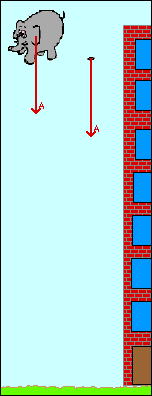REVIEW THE FOLLOWING ACTIVITIES & YOUR NOTES FOR QUIZ ON AIR RESISTANCE & FORCE ON AIRPLANE
QUIZ: Tuesday, 12/17
TYPES OF FORCE #1
TYPES OF FORCE #2
TYPES OF FORCE #3
An airplane flying straight and level at a constant speed has four forces acting on it: lift, drag, weight and thrust. Weight and mass are not the same thing.
Mass is a measure of the amount of matter in an object, while weight factors in the downward pull of gravity on an object.
In light aircraft, piston engines drive propellers. Propellers deflect air backward, and this air pushes back, creating thrust. The same principle applies to jet engines, which blast hot, expanding gases to the rear of the plane and, in turn, get pushed back by those same gases.
The forces acting on a plane work in opposing pairs. Weight opposes lift, drag opposes thrust. During steady, level flight, the pilot adjusts the engine power and various control surfaces to keep the opposing forces in balance.
Birds figured it out long before humans: You gotta have wings if you're going to fly. Wings create lift, the upward-acting force that gets your feet off the ground.
Wing sounds so simple, but airfoil soars with sophistication. Technically speaking, an airfoil is the shape of the wing -- a curved surface with a rounded leading edge and a sharp trailing edge.
Daniel Bernoulli and his famous principle get a lot of attention when it comes to lift. A lot of aviation enthusiasts would argue, however, that Bernoulli is only part of the lift story though.
Move over Bernoulli, Newton wants to fly this plane. According to authors Anderson and Eberhardt, Newton's third law of motion is perfectly capable of explaining how a wing works: Grossly simplified, it says that the wing pushes the air down, so the air pushes the wing up.
On an airfoil, the amount of curvature is determined by the camber line. Airfoils with positive camber -- the upper surface curves more than the lower surface -- generate better lift.
For an airfoil to work, the leading edge of the wing must be inclined upward. The more it's inclined, the greater the angle of attack. Put another way, the angle of attack is the angle between the chord, or midline, of an airfoil and the direction of the surrounding undisturbed flow of gas or liquid.
The angle of attack is related to the amount of lift. Lift will increase as the angle of attack is increased -- up to a point (called the critical angle of attack). For most aircraft, lift will be maximized if the angle of attack remains below 17 degrees.
While it's true that increasing the angle of attack increases lift, it's also true that you can have too much of a good thing. When the angle of attack becomes too steep, the wing can't generate lift, and the aircraft stalls.
Elevators are hinged flaps located on the tail of the plane. Raising the elevators deflects air downward, which pushes the tail down (and the nose up). Lowering the elevators pushes the tail up (and the nose down).
AIR RESISTANCE
GRAVITY
Every object in the Universe attracts every other object in the universe. This invisible force for masses to move toward each other is called Gravity.
When you weight yourself, your weight may be around 30kg to maybe 50kg because of Gravity.
Your weight is the result from the product of the force of gravity and the mass of you.
Why two masses separated in space have a gravitational attraction to one another remains unknown, despite much research and various theories.
Here are some important facts about gravity:
| Using scientific language | Which translate to... |
| Gravity is the experience of two particles mutually attracting each other along the line joining them. | Imagine yourself deep in space and you are standing next to a brick.When you are running in a marathon, you are running in a particular direction, but gravity has no particular direction, but along the path joining you and that brick. |
| Spherically symmetric objects interact gravitationally as if their mass were located at their centers. | An example of a spherically symmetric object is the Earth. Earth attracts as if it's mass were located at the centre of Earth. |
| It is gravity which causes the centripetal acceleration when a satellite moves in a circular orbit. | Gravity is what allows a satellite to move in a circular orbit around earth. |
| For a particular radius of circular orbit there is only one possible speed for a stable satellite orbit. | If a satellite wants to orbit 2,000km above Earth, there is only one speed at which it can stably orbit. |
HOW MUCH WOULD WEIGHT ELSEWHERE? (click on the link) |

